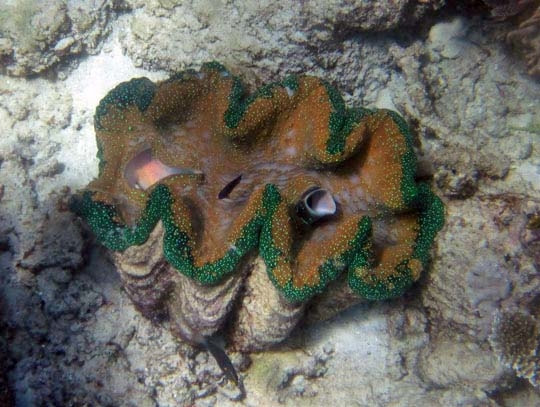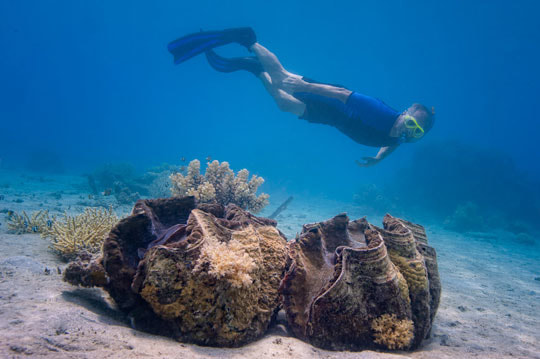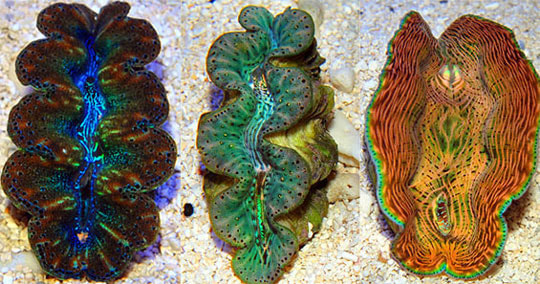|
Today's awesome animal is not one that makes an appearance in my novels. But, dang it, giant clams should be in one of my stories! Remember the old Tarzan movies (and other adventure tales) where the hero would swim to the ocean floor, only to have a giant clam clamp down on his leg? He would struggle to get loose, barely making it free before drowning. So, giant clams have gotten a bad rap (at least in the old movies). But I don't think they deserve that. When Trish and I snorkeled the Great Barrier Reef on our recent Australia trip, we saw a mind-boggling array of colorful fish and invertebrates. But even with all those amazing creatures there, my favorite was the giant clams. So what the heck is a Giant Clam? Giant clams actually include about ten species of bivalve mollusks that live in warm, shallow waters of the Indian and South Pacific Oceans. They are the largest of all the bivalve mollusks (mollusks that have two shells, like clams, oysters, mussels, scallops, and others). Below is a giant clam I saw while snorkeling off the coast of Queensland, Australia. It was between two and three feet (.6 to .9 m) from end to end. Amazing facts about the Giant Clam Giant clams are, well, giant. They can grow to more than four feet (1.2 m) and weigh over 500 pounds (227 kg). Most of this weight, however, is the shell. The soft, living portion is only about 10% of the creature's weight. Although the body is only 10% of the weight, these soft tissues are almost entirely good, healthy protein, which is why giant clams have been hunted for centuries (maybe much longer). Due to hunting, giant clams are now at risk of becoming extinct. Fortunately, these clams can live to over 100 years old. Giant clams do not eat people. Legends in the South Pacific describe giant clams waiting patiently for unsuspecting swimmers to come along so they can grab them and eat them whole. This is simply not true. There has never been a substantiated case of a human being killed by one of these gentle giants. In fact, the muscles that pull the shells closed move far too slowly to catch a swimmer by surprise. Giant clams are colorful. The portion of the live tissue you can see is called the mantle (I think of it as the clam's lips). The mantle is a different color for ever individual clam, and they can be brilliant greens, oranges, blues, or about any other color. This color is caused by iridocytes, which are cells that reflect light. Oddly, if you see a giant clam that looks green, if you swim to the other side and look at it from a different angle the color can change its hue. These brilliant giant clam iridocytes are being closely studied by scientists who hope to develop improved cell phone screens. Most TV and cell phone screens today use their own source of backlighting. But reflected light is much easier on the eyes. Giant clam iridocytes are so good at reflecting different colors of light that these cells may hold clues to creating screens that reflect ambient light (instead of being backlit). Check out this video of the colors of giant clams. How do giant clams get so huge? Oddly, they obtain their food in several ways. Most of their food comes from the symbiotic algae that live in their cells (these algae are the source of the iridocytes' colors). So, the clams can use sunlight for photosynthesis (in which light is used to convert carbon dioxide into food/energy). Giant clams also feed on plankton by filtering it from the water. The nutrients from the plankton help feed the algae in the clam's cells. Complicated, huh? One species of giant clam has perfected the ship-in-a-bottle trick. These clams, when relatively small, burrow into the stone-like surface of a coral reef. They end up with only their mantle (the "lips") showing. As they grow, they get too big to fit through the hole in the rock (although high acidity in a layer of tissue around their shells eats away at the surrounding rock so that their cavity grows as their shell grows). So for multiple decades of their life, they are trapped in the rock-hard reef. Below is a photo of one of these clams I found while snorkeling. All you can see is its lips. So, the giant clam deserves a place in the K.A.H.O.F. (Kryptonian Animal Hall of Fame). FUN FACT: Okay, maybe this one's a bit of a stretch, but I like it. The word Kryptonian actually refers to the advanced race of aliens from the planet Krypton (you know... from Superman). Gradually it evolved into an adjective that describes anything associated with the planet or the race. And then (this is the part that might be based on my own wishful thinking), it evolved into an adjective to describe anything spectacular (the Kryptonians, including Superman, were spectacular, right?). So, in my opinion, kryptonian is another way to say awesome! Photo Credits:
Giant Clam #1 - Stan C. Smith Giant Clam and Snorkler - AvatarLogs.com Giant Clam Different Colors - LiveAquaria Giant Clam buried in Coral Rock - Stan C. Smith
0 Comments
Leave a Reply. |
Stan's Cogitations
Everyone needs a creative outlet. That's why I write. Archives
July 2024
|





 RSS Feed
RSS Feed